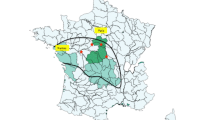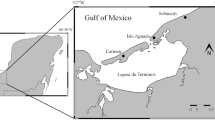Abstract
Chlorinated hydrocarbons such as polychlorinated biphenyls (PCBs) and chlorinated insecticides have often been detected in Great Lakes fish-eating birds at concentrations that are correlated with greater than expected embryo mortality and reduced reproductive success. Blood from 111 known-age, adult Caspian terns (Sterna caspia) nesting in several regions of the upper Great Lakes was collected in 1990 to examine bioavailability of PCBs, to compare concentrations of PCBs among nesting locations, and to determine relationships between concentrations of PCBs and age, productivity, and colony site tenacity. PCBs, DDE, dieldrin, and trans-nonachlor were detected in all the samples. Concentrations of PCBs were, on average, 10, 100, and 250 times greater than those of DDE, dieldrin, and trans-nonachlor, respectively. Concentrations of PCBs were not correlated with age, and were greater in Caspian terns from Saginaw and Green Bays than in Caspian terns from the North Channel and Georgian Bay. Concentrations of PCBs and DDE were significantly correlated with one-another and their accumulation patterns were the most similar among all the chemicals studied. Patterns of organochlorines as determined by cluster analysis were most similar for the nearest nesting locations. The bioaccumulation of PCBs in Great Lakes Caspian terns appeared to be seasonal and did not vary with adult age. A significant negative correlation was observed between mean concentrations of PCBs by region and percent terns returning to natal region. Those populations which were likely to be affected by PCBs were those nesting in Green Bay and Saginaw Bay.
Similar content being viewed by others
References
Anderson DW, Hickey JJ (1972) Eggshell changes in certain North American birds. Proc Int Ornithol Congr 15:514–540
—, — (1976) Dynamics of storage of organochlorine pollutants in herring gulls. Environ Pollut 10:183–200
Bierman VJ, Swain WR (1982) Mass balance modeling of DDT dynamics in lakes Michigan and Superior. Environ Sci Technol 16:572–579
Bishop C, Weseloh DV (1990) Contaminants in herring gull eggs from the Great Lakes. Environment Canada, SOE Fact Sheet 90-2
Burkhard LP, Weininger D (1987) Determination of polychlorinated biphenyls using multiple regression with outlier detection and elimination. Anal Chem 59:1187–1190
Burse VW, Head SL, Korver MP, McClure PC, Donahue JF, Needham LL (1990) Determination of selected organochlorine pesticides and polychlorinated biphenyls in human serum. J Anal Toxicol 14:137–142
Capen DE, Leiker TJ (1979) DDE residues in blood and other tissues of white-faced ibis. Environ Pollut 19:163–171
Cuthbert FJ (1985) Intraseasonal movement between colony sites by Caspian terns in the Great Lakes. Wilson Bull 97:502–510
— (1988) Reproductive success and colony-site tenacity in Caspian terns. Auk 105:339–344
Fox GA, Collins B, Hayakawa E, Weseloh DV, Ludwig JP, Kubiak TJ, Erdman TC (1991) Reproductive outcomes in colonial fisheating birds: a biomarker for developmental toxicants in Great Lakes food chains. II. Spatial variation in the occurrence and prevalence of bill defects in yound double-crested cormorants in the Great Lakes, 1979–1987. J Great Lakes Res 17:158–167
Friend M, Haegle MA, Meeker DL, Hudson R, Baer CH (1979) Correlations between residues of dichlorodiphenyl ethane, polychlorinated biphenyl, and dieldrin in the serum and tissues of mallard ducks (Anas platyrhynchos). In: Animals as monitors of environmental pollutants, National Academy of Sciences, Washington, DC, pp 319–326
Gilbertson M (1974) Seasonal changes in organochlorine compounds and mercury in common terns of Hamilton Harbour, Ontario. Bull Environ Contain Toxicol 12:726–732
Gilbertson M, Morris RD, Hunter RA (1976) Abnormal chicks and PCB residue levels in eggs of colonial birds on the lower Great Lakes (1971–73). Auk 93:434–442
Gilbertson M, Kubiak T, Ludwig J, Fox G (1991) Great Lakes embryo mortality, edema, and deformities syndrome (GLEMEDS) in colonial fish-eating birds: Similarity to chick-edema disease. J Toxicol Environ Health 33:455–520
Gill RE Jr, Mewaldt LIZ (1983) Pacific Coast Caspian terns: Dynamics of an expanding population. Auk 100:369–381
Heinz GH, Erdman TC, Haseltine SD, Stafford C (1985) Contaminant levels in colonial waterbirds from Green Bay and Lake Michigan, 1975–1980. Environ Monit Assess 5:223–236
Henny CJ, Meeker DL (1981) An evaluation of blood plasma for monitoring DDE in birds of prey. Environ Pollut 25:291–304
Hoffman DJ, Rattner BA, Sileo L, Docherty D, Kubiak TJ (1987) Embryotoxicity, teratogenicity, and aryl hydrocarbon hydroxylase activity in Forster's terns on Green Bay, Lake Michigan. Environ Res 42:176–184
Kubiak TJ, Harris HJ, Smith LM, Schwartz TR, Stalling DL, Trick JA, Sileo L, Docherty DE, Erdman TC (1989) Microcontaminants and reproductive impairment of the Forster's tern on Green Bay, Lake Michigan—1983. Arch Environ Contain Toxicol 18:706–727
Kurita H, Ludwig JP (1987) Results of the 1987 Michigan colonial waterbird monitoring project on Caspian terns and double-crested cormorants: Egg incubation and field studies of colony productiv ity, embryologic mortality and deformities. Special report to the Michigan Department of Natural Resources, Ecological Research Services, Inc Ann Arbor, MI
L'Arrivee L, Blokpoel H (1988) Seasonal distribution and site fidelity in Great Lakes Caspian terns. Colonial Waterbirds 11:202–214
Ludwig JP (1965) Biology and structure of the Caspian tern (Hydroprogne caspia) population of the Great Lakes from 1896–1964. Bird-Banding 36:217–233
— (1979) Present status of the Caspian tern population of the Great Lakes. Michigan Academician 12:69–77
Ludwig JP, Tomoff CS (1966) Reproductive success and insecticide residues in Lake Michigan herring gulls. Jack-Pine Warbler 44:78–84
Ludwig JP, Auman HJ, Kurita H, Ludwig ME, Campbell LM, Giesy JP, Tillitt DE, Jones PD, Yamashita N, Tanabe S, Tatsukawa R (in press) Caspian tern reproduction in the Saginaw Bay ecosystem following a 100-year flood event. J Great Lakes Res
Mendenhall VM, Klaas EE, McLane MAR (1983) Breeding success of barn owls (Tyto alba) fed low levels of DDE and dieldrin. Arch Environ Contain Toxicol 12:235–420
Mineau P, Fox GA, Norstrom RJ, Weseloh DV, Hallett DJ, Ellenton JA (1984) Using the herring gull to monitor levels and effects of organochlorine contamination in the Canadian Great Lakes. In Nriagu JO, Simmons MS (eds) Toxic contaminants in the Great Lakes, John Wiley and Sons, Inc, NY, pp 425–452
Mitchell CA, Custer TW (1986) Hatching success of Caspian terns nesting in the lower Laguna Madre, Texas, USA. Colonial Waterbirds 9:86–89
Monro AM (1990) Interspecies comparisons in toxicology: The utility and futility of plasma concentrations of the test substance. Regul Toxicol Pharmacol 12:137–160
Neter JW, Wasserman W, Kutner ME (1985) Applied linear statistical models, 2nd ed. RD Irwin Inc., Homewood, IL
Norden CR (1967) Age, growth and fecundity of the alewife,Alosa pseudoharengus (Wilson), in Lake Michigan. Trans Am Fish Soc 96:387–393
Ribick MA, Dubay GR, Petty JD, Stalling DL, Schmitt CJ (1982) Toxaphene residues in fish: identification, quantification, and conformation at part per billion levels. Environ Sci Technol 16:310–318
Schecter A, Papke O, Ball M, Ryan JJ (1991) Partitioning of dioxins and dibenzofurans: whole blood, blood plasma and adipose tissue. Chemosphere 23:1913–1919
Shugart GW, Scharf WC, Cuthbert FJ (1978) Status and reproductive success of the Caspian tern (Sterna cassia) in the U.S. Great Lakes. Proc Colonial Waterbird Group 146–156
Soikkeli M (1973) Breeding success of the Caspian tern in Finland. Bird-Banding 44:196–204
Stickel LF, Stickel WH, McArthur RD, Hughes DL (1979) Chlordane in birds: a study of lethal residues and loss rates. 387–396 In Deichman WB, Organizer (eds) Toxicology and occupational medicine. Elsevier/North-Holland, New York
Struger J, Weseloh DV (1985) Great Lakes Caspian terns: Egg contaminants and biological implications. Colonial Waterbirds 8:142–149
Tanabe S, Kannan N, Subramanian A, Watanabe S, Tatsukawa R (1987) Highly toxic coplanar PCBs: Occurrence, source, persistency and toxic implications to wildlife and humans. Environ Pollut 47:147–163
Taylor JK (1987) Quality assurance of chemical measurements. Lewis Publishers, Inc, Chelsea, MI
Tillitt DE, Ankley GT, Verbrugge DA, Giesy JP, Ludwig JP, Kubiak TJ (1991) H4IIE rat hepatoma cell bioassay-derived 2,3,7,8-tetrachlorodibenzo-p-dioxin equivalents in colonial fish-eating waterbird eggs from the Great Lakes. Arch Environ Contain Toxicol 21:91–101
Weseloh DV, Teeple SM, Gilbertson M (1983) Double-crested cormorants of the Great Lakes: Egg-laying parameters, reproductive failure, and contaminant residues in eggs, Lake Huron, 1972–1973. Can J Zool 61:427–436
Wilkinson L (1990) SYSTAT: The system for statistics. SYSTAT, Inc, Evanston, IL
Williams LL, Giesy JP, DeGalan N, Verbrugge DA, Tillitt DE, Ankley GT, Welch RL (1992) Prediction of concentrations of 2,3,7,8-tetrachlorodibenzo-p-dioxin equivalents from total concentrations of polychlorinated biphenyls in fish fillets. Environ Sci Technol 26:1151–1159 R (in press) Embryonic abnormalities and organochlorine contamination in double-crested cormorants (Phalacrocorax auritus) and Caspian terns (Hydroprogne caspia) from the upper Great Lakes. II. Identity and levels of individual PCB, PCDD, PCDF, and organochlorine pesticides in eggs collected in 1988. Environ Pollut
Author information
Authors and Affiliations
Rights and permissions
About this article
Cite this article
Mora, M.A., Auman, H.J., Ludwig, J.P. et al. Polychlorinated biphenyls and chlorinated insecticides in plasma of Caspian terns: Relationships with age, productivity, and colony site tenacity in the great lakes. Arch. Environ. Contam. Toxicol. 24, 320–331 (1993). https://doi.org/10.1007/BF01128730
Received:
Revised:
Issue Date:
DOI: https://doi.org/10.1007/BF01128730




